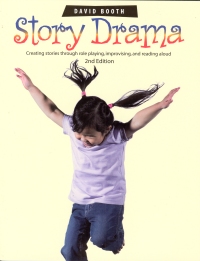| ________________
CM . . .
. Volume XII Number 20 . . . .June 9, 2006 
 |
Story Drama: Creating Stories Through Role Playing, Improvising and Reading Aloud. 2nd. ed.
David Booth.
Markham, ON: Pembroke, 2005.
153 pp., pbk., $23.95.
ISBN 1-55138-192-3.
Subject Headings:
Drama in education.
Language arts-Correlation with content subjects.
Language arts (Elementary).
Professional.
Review by Jocelyn A. Dimm.
**** /4 |
| |
|

excerpt:
In story drama, there is the story we begin with – our shared story; the story of the drama – our created story; and the stories triggered by the drama from the students’ life experiences – our own life stories. As teachers, we work with students as co-constructors of a common story, represented through drama, based on and integrating pieces of the stories we have met and lived. As a community, we build another story together until we have our story told and shown “in action.” Story drama is a process whereby those involved create a new story that all of us own.
Drama allows us to tell stories, to engage in the art of narrative. The simplest retelling of yesterday’s events is an act of the imagination, as we have the option of reinventing the characters, experiences, circumstances, motivations, and outcomes. Fictional storytelling, like drama, encompasses and extends the possibilities of human experience.
In the second edition of Story Drama, David Booth once again, provides a valuable collection of approaches to learning through literature and drama for educators wanting to explore, preparing to experience, or already engaging in story drama strategies in the classroom.
In 12 diverse chapters, Booth addresses the multiple ways meanings are constructed and encountered through students’ dramatic engagement with stories. In his introduction, Booth shares his own personal teaching experiences, a definition of story drama, advice gleaned from other dramatists, and strategies for supporting story drama in the classroom. From here, each chapter offers a significant contribution: (1) building a story community, (2) involving the students in planning for story drama, (3) exploring stories through dramatic activities, (4) finding dramatic ways for students to retell stories, (5) choosing structures for creating drama on the story, (6) creating new stories together using drama, (7) writing inside and outside of the drama experience, (8) finding strategies for supporting literacy through drama, (9) using students’ knowledge and expertise to structure the story drama, (10) helping students make art and life connections, (11) sharing story dramas as actors and audience, and (12) assessing learning from story drama.
The text includes guiding story drama examples and strategies in every chapter with instructions laid out succinctly and practically for teaching purposes. The text also provides an index but chooses not to include a list of references. Instead, Booth inserts quotes and references into the margins throughout the text. Although these quotes and references are valuable, they are limited to names of authors and texts. Perhaps, for all of us wishing for a quicker access to these resources, Booth (and publishers) could be persuaded, in a 3rd edition to present a more detailed list of references as well.
Story Drama is an insightful invaluable resource for educators wishing to broaden the learning experiences and possibilities for the students in their classrooms.
Highly Recommended.
Jocelyn A. Dimm is a sessional instructor and a PhD Candidate at the University of Victoria where she teaches drama education and young adult literature in the Faculty of Education.

To comment
on this title or this review, send mail to cm@umanitoba.ca.
Copyright © the Manitoba Library Association. Reproduction for personal
use is permitted only if this copyright notice is maintained. Any
other reproduction is prohibited without permission.
NEXT REVIEW |
TABLE OF CONTENTS FOR THIS ISSUE
- June 9, 2006.
AUTHORS |
TITLES |
MEDIA REVIEWS |
PROFILES |
BACK ISSUES |
SEARCH |
CMARCHIVE |
HOME |
